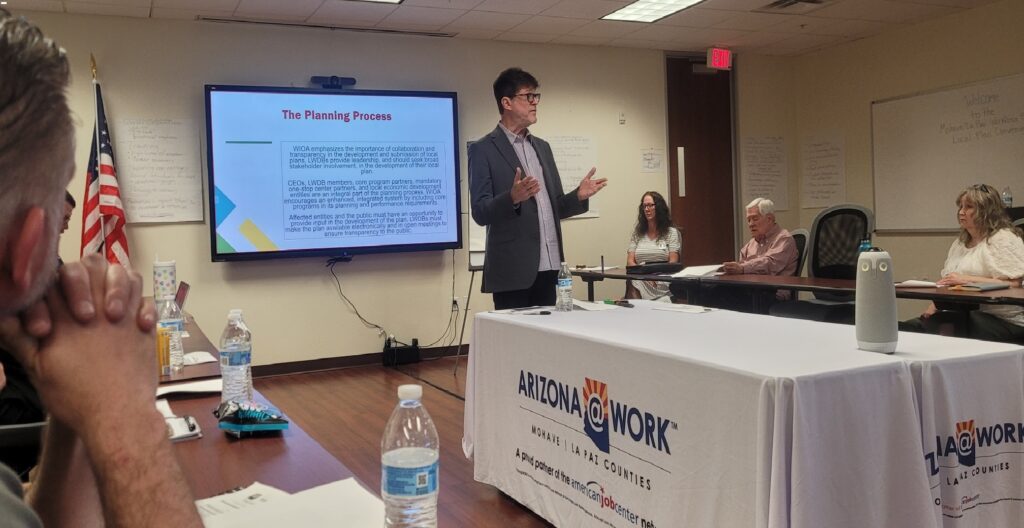
KINGMAN – On Thursday, April 11 the Mohave/La Paz County LWDB (Local Workforce Development Board) met with about 20 businessowners and agency heads to get input for updating its four-year plan and programs. The plan is required by the WIFO (Workforce Innovation and Opportunity Act). The programs are funded by the federal government.
A PowerPoint presentation was used by David Shinder, Workforce Development Consultant, to provide guidance for discussion on current and projected needs in Mohave and La Paz counties as far as industry and occupations.
The current local plan covering 2020-2023 identifies construction, healthcare and social assistance, transportation and warehouse, manufacturing, leisure and hospitality and administration and waste services as target sectors.
Shinder said Mohave and La Paz counties receive federal funds from the State of Arizona every year under the WIOA. He further stated the Board is interested in what matters most to business owners and managers within key industries with regard to workforce issues; and, as well, what they foresee as emerging industries or businesses.
“WIOA is designed to help job seekers access employment, education, training, and support services to succeed in the labor market and to match employers with the skilled workers they need to compete in the global economy,” stated Shinder.
Housing and healthcare were identified by the group as two of the top tier target sectors. There was discussion regarding a shortage of early childhood education professionals who mostly left the profession after the pandemic and must be replaced. As well, there is a shortage of CNAs (certified nursing assistants) and daycare workers in the region.
Julius Pearson, Chief Human Resources Officer for KRMC (Kingman Regional Medical Center) stated they, and the community as a whole, are experiencing a shortage of CNAs and nurses. He said the hospital has reduced its traveling nurses by about 50% and realized a savings.
“We have reduced our agency expense by about $20 million annually,” he said. “We took that money and we reinvested it in our staff so we could attract those nurses from California and from Nevada to be sure that when patients come to our hospital there is no staffing crisis; so (that) they can be seen and cared for properly.”
He explained that permanence not only pertains to the care received but also to our tax base. “When you have someone that only comes into your community for a short period of time, the level that we found, the level of care that they provide, is sometimes at cross purposes.
“So, we want people who live in our community who are invested in our community, that are willing to learn the KRMC way; because there are standards that we demand that are met when it comes to our patients and it’s easier to affect that when the employees are yours.”
As for industry growth, IT was one of the mentioned growing industries.
Chairwoman of the local Mohave/La Paz board, Kenda Robinson, who is a recruiter for ALLO Communications, stated they had 380 employees in a short time and that they are growing very quickly.
“We are on fire, we have right now about 340 positions that we need to fill between Havasu and Yuma,” she said. Additionally, she said they are growing so quickly that they went from 400 employees between Colorado and Arizona to 1600 in a short time.
“We have nothing in common (with other businesses) as far as trying to find people to come to work for us,” she stated. “I don’t do a lot of outsourcing as far as looking for talent. I open up the website and I have 200 to 300 applicants waiting to be employed with us.”
New businesses within existing industries such as lithium slurry processing was mentioned as well as IT and robotics. As well, a lack of infrastructure was discussed as a challenge to new businesses.
Challenges related to worker recruitment reported were lack of skills as well as a motivation deficit, changing worker expectations and a lack of childcare. In some industries wages and benefits were a factor. As to motivation, one employer stated he hired a new employee who never showed up to work.
The local boards in each county or jurisdiction work together through one organization, Arizona@Work, and the goal is to provide innovative workforce solutions to employers and job seekers. Services are provided at no charge. Interested employers and job seekers can get information at https://arizonaatwork.com/locations/mohave-and-la-paz-counties or by calling 928-753-0723.
Once the four-year plan is developed it will be approved by the local workforce development board and then, after a 30-day public comment period, forwarded to the chief locally elected officials.
Becky Foster
